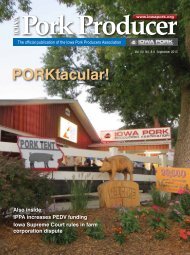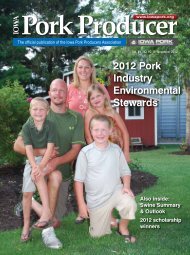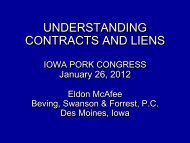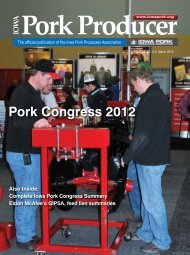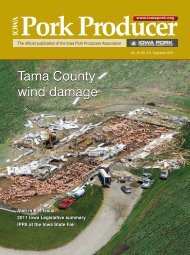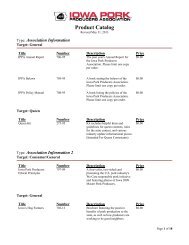Effective Employee Training to Build Barn Culture - Iowa Pork ...
Effective Employee Training to Build Barn Culture - Iowa Pork ...
Effective Employee Training to Build Barn Culture - Iowa Pork ...
You also want an ePaper? Increase the reach of your titles
YUMPU automatically turns print PDFs into web optimized ePapers that Google loves.
<strong>Effective</strong> <strong>Employee</strong> <strong>Training</strong> <strong>to</strong><strong>Build</strong> <strong>Barn</strong> <strong>Culture</strong>We need people <strong>to</strong> make pigs.Sarah Probst Miller, DVM
<strong>Employee</strong> attitude• <strong>Employee</strong> attitude can drastically impactproductivity on farm
Skiing and Pigs• 80% of first time skiers never come back– Bad experience– Poor teacher– Pushed beyond level– No training
What has the biggest impact onemployee attitude?
What has the biggest impact onemployee attitude?
What is employee engagement?• The ability <strong>to</strong> capture the heads and hearts ofyour employees <strong>to</strong> instill an intrinsic desireand passion for excellence.• Wanting their organization <strong>to</strong> succeedbecause they feel connected emotionally andsocially <strong>to</strong> its mission, vision, and purpose.AASV 2009 Firkins Hogg Lecture.6
What we are facing• 2000: 26% of workers were engaged• 2002: 31% of workers were engaged• 2005: 28% of workers were engagedAASV 2009 Firkins Hogg Lecture.7
The Value of Engaged <strong>Employee</strong>s• 27% lower absenteeism• 31% less likely <strong>to</strong> leave the organization• 62% reduction in work-related accidents• 18% more productive• 12% more profitable• In hospitals: 21% lower “avoidable deaths”AASV 2009 Firkins Hogg Lecture.8
Do you know how your employeeswould answer?• 15% of employees are being called by a name theydo not prefer• 39% can provide a clear answer on knowing whatthey get paid <strong>to</strong> do• Benefit of tapping in<strong>to</strong> what people are passionateabout: sources of energy• Do you know what your employees count as success?Have you celebrated those successes?AASV 2009 Firkins Hogg Lecture.9
People are our greatest asset• Most companies use this line, few understandwhat it means• Do you believe your ordinary employees canbe the source of extraordinary results?• Have you adequately communicated this?• Securing our future is going <strong>to</strong> requireinnovation on our part and on the part of ouremployeesAASV 2009 Firkins Hogg Lecture.10
Workforce Engagement Study• 17% of employees are highly engaged• 64% (most) are moderately engaged• 19% are disengaged•Fernandez CP. <strong>Employee</strong> engagement. Journal of Public Health Management and Practice 2007;13(5):524-526.
Measuring employee engagementGallup, Inc. Developed Survey• Designed <strong>to</strong> assess employee engagement– Aids in management of employees• Survey known by “Q12”– Asks 12 questions related <strong>to</strong> aspects of employeeengagement• Book contains suggestions per question <strong>to</strong> improveengagement.• Has been used successfully in other industries.
Q12 Survey Questions1. I know what is expected of me at work.2. I have the materials and equipment I need <strong>to</strong> do my work right.3. At work, I have the opportunity <strong>to</strong> do what I do best every day.4. In the last seven days, I have received recognition or praise for doinggood work.5. My supervisor, or someone at work, seems <strong>to</strong> care about me as aperson.7. There is someone at work who encourages my development. At work,my opinions seem <strong>to</strong> count.8. The mission or purpose of my company makes me feel my job isimportant.9. My associates or fellow employees are committed <strong>to</strong> doing qualitywork.10. I have a best friend at work.11. In the last six months, someone at work has talked <strong>to</strong> me about myprogress.12. This last year, I have had opportunities at work <strong>to</strong> learn and grow.
Q12 Survey Questions (cont.)• Each question answered on a scale of 1 <strong>to</strong> 5– 1 representing strong disagreement– 5 representing strong agreement• Questions reflect aspects of employeeengagement described in the literatureBakker AB, Schaufeli WB, Leiter MP, Taris TW. Work engagement: Anemerging concept in occupational health psychology. Work & Stress2008;22(3):187-200.
New Study for Swine Industry• Designed as a preliminary investigation in<strong>to</strong>possible correlations between employeeengagement and easily defined productionparameters
Results Indicate• Statistically significant (positive) correlationbetween PSY and overall employeeengagement as determined by survey results– At p=0.057, no statistically significant correlationbetween PWM and overall employee engagement– At p=0.45 and 0.46 respectively, no significantcorrelations between SB or FR and overallemployee engagement
<strong>Employee</strong> Engagement and the SwineIndustry—Take Home Message• Results indicate employee engagement is asvalid in the swine industry as in otherindustries.• As an industry and as industry leaders, weshould be measuring and working <strong>to</strong> improveemployee engagement as a means <strong>to</strong> improveproduction.
Are you a good communica<strong>to</strong>r?Is that skill natural or somethingyou’ve learned?Can it be taught?
What does good communication in theswine industry look like?• Flexing <strong>to</strong> behavioural style• Flexing <strong>to</strong> employment tier• Knowing how <strong>to</strong> use operational drivers asmotivational fac<strong>to</strong>rs across the 4 tiers ofemployment in the swine industry
Who is your audience?Everyone
Everyone?EVERYONE.How we communicate is very important.Delivery matters.
What is my message?Everyone
What is our message?
It has <strong>to</strong> be our message.
It has <strong>to</strong> be our message.STEP 1: The process of making it ourmessage is the first step ofimplementing the plan and the mostimportant step of the plan. Withoutsucceeding here, we will become theflying elephant.
<strong>Build</strong>ing Swine Business Acumen: UsingOperational Drivers as MotivationalFac<strong>to</strong>rs across Four Tiers of Employmentin the Swine IndustryAchieving New Heights in Learning
<strong>Build</strong>ing Swine Business Acumen: UsingOperational Drivers as Motivational Fac<strong>to</strong>rsacross Four Tiers of Employment in the SwineIndustryGoal – To create more effective agents of change within the pork industryWean-<strong>to</strong>-Market• Intro: Wean-<strong>to</strong>-Finish Operational Drivers –TiersFlexing <strong>to</strong> Employment•Focus on ADG and Impact as Operational Drivers – Flexing <strong>to</strong>Employment Tiers•Focus on Mortality and FCR as Operational Drivers – Flexing <strong>to</strong>Employment Tiers•Focus on Profit Analysis as Operational Drivers – Flexing <strong>to</strong> EmploymentTiers•Concluding session: Wean-<strong>to</strong>-Finish Operational Drivers – Flexing <strong>to</strong>Employment TiersBreed-<strong>to</strong>-Wean• Swine Business Acumen: Sow Farm Operational Drivers•Intro: Sow Farm Operational Drivers – Flexing <strong>to</strong>Employment Tiers and Behavioral Styles•Focus on Breeding/Farrowing Targets and Pig Flow – Flexing<strong>to</strong> Employment Tiers and Behavioral Styles•Focus on Mortality – Flexing <strong>to</strong> Employment Tiers andBehavioral Styles•Focus on Inputs and Associated Costs– Flexing <strong>to</strong>Employment Tiers and Behavioral Styles•Focus on Profit Analysis – Flexing <strong>to</strong> Employment Tiers andBehavioral Styles•Concluding: Sow Farm Operational Drivers – Flexing <strong>to</strong>Employment Tiers and Behavioral Styles
Goals for Course• Goal #1: Understanding the swine business structure• Goal #2: Understanding operational drivers for four tiersof employment in the swine business structure• Goal #3: Understanding how <strong>to</strong> calculate andcommunicate operational drivers• Goal #4: Understanding how <strong>to</strong> use operational drivers asmotivational fac<strong>to</strong>rs for each employment tier• Goal #5: Get practice and feedback at using operationaldrivers as motivational fac<strong>to</strong>rs for the four tiers ofemployment
<strong>Training</strong> developmentWe are a group of professionals that understandanimal agriculture and agribusiness.We have a passion for sharing that knowledgewith others through the development anddelivery of science based creative learning<strong>to</strong>ols.We understand that measurements of progressand impact are the most important part ofsuccessful learning programs.probst@hogvet.com34







